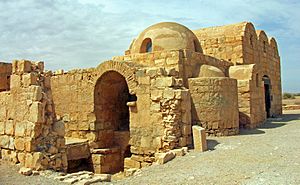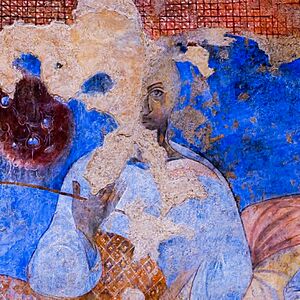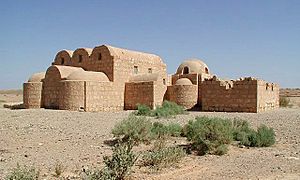Qusayr 'Amra facts for kids
Quick facts for kids Qusayr 'Amra, Qasr Amra |
|
|---|---|
| Native name Arabic: قصر عمرة |
|

East (front) elevation and portion of south profile, 2009
|
|
| Location | Zarqa Governorate, Jordan |
| Elevation | 520m |
| Built | 743 A.D. |
| Official name: Quseir Amra | |
| Type | Cultural |
| Criteria | i, iii, iv |
| Designated | 1985 (9th session) |
| Reference no. | 327 |
| Region | Arab States |
| Lua error in Module:Location_map at line 420: attempt to index field 'wikibase' (a nil value). | |
Qusayr 'Amra (also called Qasr Amra) is a famous "desert castle" in eastern Jordan. It means "small castle of 'Amra" in Arabic. This special building was constructed between 723 and 743 AD. It was built by Walid Ibn Yazid, who later became the Umayyad ruler Walid II.
Qusayr 'Amra is a very important example of early Islamic art and architecture. It was once part of a much larger complex. This complex included a real castle, but only its foundations remain today. What you see now is a small country house or cabin.
The building is most famous for its amazing paintings, called frescoes, found mostly on the ceilings inside. These paintings show many different things. You can see a group of rulers, scenes of hunting, and people dancing. There are also pictures of workers and a newly found series of paintings about Jonah. Above one of the bath rooms, there is the first known painting of the night sky on a curved surface. It shows constellations and the zodiac signs.
Because of these unique frescoes, Qusayr 'Amra is a UNESCO World Heritage Site. The bathhouse here is also one of the oldest surviving examples of a hammam in the Muslim world. Its special status and easy location near Amman make it a popular place for tourists to visit.
Contents
Where to Find Qusayr 'Amra
Qusayr 'Amra is located on the north side of Jordan's Highway 40. It is about 85 kilometers (53 miles) from Amman. You can find it about 21 kilometers (13 miles) southwest of Al-Azraq.
The site is surrounded by a fence. There is a paved parking lot right off the road for visitors. A small building acts as a visitor's center where you pay to enter. The castle itself is located on the western side of this fenced area, sitting below a small hill.
What Does Qusayr 'Amra Look Like?
Long ago, stone walls surrounded the site. This suggests it was part of a very large complex, covering about 25 hectares (62 acres). There are also remains of a castle that might have housed soldiers for a short time.
Near the building, to the southeast, there is a well that is 40 meters (130 feet) deep. People have also found traces of an old animal-powered system that used to lift water from the well.
The main building, which served as a reception hall and bathhouse, looks very similar to another old bathhouse called Hammam al-Sarah in Jordan. However, Qusayr 'Amra was built using rough stones held together with a mix of gypsum and lime. This style is similar to ancient Persian buildings.
The castle is a low building made from limestone and basalt rocks. The northern part has two stories and a special triple-vaulted ceiling over the main entrance on the east side. The western parts have smaller arched ceilings or domes.
Today, Qasr Amra is not in as good condition as some other desert castles like Qasr Kharana. Some of its beautiful frescoes have been damaged by graffiti. But, there are ongoing efforts to protect and fix the site. Groups like the World Monuments Fund and Jordan's Department of Antiquities are working to restore it.
History of the Castle
Who Built Qusayr 'Amra and When?
For a long time, experts thought that the caliph Walid I built Qasr Amra around 710 AD. This was partly because one of the paintings shows six kings, including Roderic, a king of Spain who ruled from 710-712 AD.
However, new discoveries in 2012 helped to set the date more accurately. An inscription found during restoration work showed that the building was made between 723 and 743 AD. It was built by Walid Ibn Yazid. He was a crown prince under Caliph Hisham and later became caliph himself for a short time in 743–744 AD.
Both Walid and another prince, Yazid, spent a lot of time away from Damascus, which was the Umayyad capital. Walid was known for enjoying fun activities, like listening to music by pools. He even had performers dressed as stars and constellations, which might connect to the sky painting in the hot bath room. Yazid's mother was a Persian princess, so he knew a lot about Persian culture. He also enjoyed similar pleasures.
These desert castles were often built near old trade routes. A major route went from the Arabian city of Tayma through Wadi Sirhan to the plain of Balqa in Jordan. This explains why Qusayr 'Amra and other castles like Qasr Al-Kharanah were built in these locations.
How Qusayr 'Amra Was Found Again
The castle was forgotten for many years until Alois Musil rediscovered it in 1898. The frescoes became famous through drawings made by Austrian artist Alphons Leopold Mielich for Musil's book. In the late 1970s, a team from Spain worked to restore the frescoes.
In 1985, Qusayr 'Amra was named a UNESCO World Heritage Site. It was recognized as a "masterpiece of human creative genius" and a "unique example of a cultural tradition." It also shows an important stage in human history.
Protecting the Castle
Since 1970, many projects have worked to protect Qusayr 'Amra and its frescoes. The first big project was from 1971 to 1974. It focused on cleaning the frescoes and covering them with a protective layer. However, this layer actually caused more damage over time and had to be removed later.
Current Protection Efforts
A new protection project started in 2010 and is still ongoing. This project is a team effort by the World Monuments Fund, an Italian institute, and Jordan's Department of Antiquities. This team is not only working on the bathhouse and its frescoes but also on other parts of the site. They are fixing the main castle building, the water wheel system (called a saqiya), and the watch tower.
They started by carefully recording the condition of all the paintings and the building. They added lime mortar to parts of the structure that were leaking water or losing their original mortar. They also put in new windows and ceiling covers to stop water from getting inside and to protect the building from bad weather. When they removed the old protective layer and cleaned the paintings, they found bright, rich colors that had been hidden for a long time.
Amazing Frescoes

Qusayr 'Amra is most famous for the beautiful frescoes painted on its inside walls. These frescoes are important not just for their beauty. They also show how Islamic art began and grew, especially during the Umayyad Period. The paintings show many different scenes, including: hunting, bathing, animals, plants, mythical figures, and even some religious scenes.
The Throne Room Painting
One famous painting, known as the "six kings," shows the Umayyad caliph and rulers from other lands. We know four of these kings are the Byzantine Emperor, the Visigothic king Roderic, the Persian Shah, and the Negus of Ethiopia. The last king was a mystery for a long time, but is now known to be the emperor of China.
Near this painting, the Greek word ΝΙΚΗ (nike), meaning victory, was found. This suggests the painting might have shown the caliph's power over his enemies. Another idea is that the six figures are shown asking for something, perhaps from the Caliph who would have sat in the hall.
Bathhouse Paintings
The frescoes in most of the bath rooms follow ideas from Arab doctors of that time. They believed that bathing could make people feel tired. To help "revive" them, the bath walls should have pictures of fun activities. These included hunting, people enjoying themselves, and gardens with palm trees.
Changing Room (Apodyterium)
The apodyterium, or changing room, has paintings of animals acting like humans, especially playing music. One painting shows an angel looking down at a covered human shape. Some people think it shows a death scene, but others believe it might show two people together. Three dark faces on the ceiling are thought to represent different stages of life. Some Christians in the area believe the middle figure is Jesus Christ.
Warm Bath Room (Tepidarium)
On the walls and ceiling of the tepidarium, or warm bath, there are scenes of plants and trees. These are similar to the mosaics found in the Umayyad Mosque in Damascus. Two of the three frescoes showing women bathing in Qusayr 'Amra are in this room. These paintings show women carrying water buckets to bathe children. They also include small winged figures, like those from Roman art. These women are shown without clothes, which was common in Umayyad art for non-religious buildings. The Roman style backgrounds suggest these scenes might be part of a story about the god Dionysus. Since women were not allowed in public bathhouses, the women in these paintings were likely goddesses. The scenes are simple, with only a few figures, so viewers could focus on what was happening. A painting of a woman pouring water over someone's head would have looked like what happened in the room, connecting the art to the people using the bath.
Hot Bath Room (Caldarium)
The caldarium, or hot bath, has a dome shaped like half a sphere. On this dome, there is a painting of the heavens. It shows the zodiac signs and 35 different constellations. This is thought to be the earliest painting of the night sky on a curved surface. The lines showing the constellations come from the north celestial pole, which is scientifically accurate. The angle of the zodiac is also shown correctly. Painting this fresco on a dome was very hard. Even though the artist had to redo parts, they were very skilled and focused on being accurate. The only small mistake is that the stars are in a counterclockwise order. This suggests the artist copied the image from a flat surface.
See also
 In Spanish: Qusair Amra para niños
In Spanish: Qusair Amra para niños
- Turkish bath (Islamic bathhouse)
- List of World Heritage Sites in Jordan




